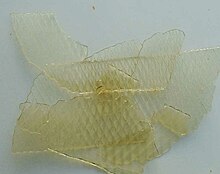
Back Ictiocol·la Catalan Vyzina Czech Hausenblase German Cola de pescado Spanish Kalaliim Estonian Colle de poisson French Riblje tutkalo Croatian Iktiokolo IO Colla di pesce Italian アイシングラス (食材) Japanese


Isinglass (/ˈaɪzɪŋɡlæs, -ɡlɑːs/ EYE-zing-gla(h)ss) is a form of collagen obtained from the dried swim bladders of fish. The English word origin is from the obsolete Dutch huizenblaas – huizen is a kind of sturgeon, and blaas is a bladder,[1] or German Hausenblase, meaning essentially the same.[2] The bladders, once removed from the fish, processed, and dried, are formed into various shapes for use.
It is used mainly for the clarification or fining of some beer and wine. It can also be cooked into a paste for specialised gluing purposes.
Although originally made exclusively from sturgeon, especially beluga, in 1795 an invention by William Murdoch facilitated a cheap substitute using cod. This was extensively used in Britain in place of Russian isinglass, and in the US hake was important. In modern British brewing all commercial isinglass products are blends of material from a limited range of tropical fish.[3]
- ^ (Chambers 20th century dictionary)
- ^ Wedgwood, Hensleigh (1855). "On False Etymologies". Transactions of the Philological Society (6): 66.
- ^ Baxter ED, Cooper D, Fisher GM, Muller RE (2007). "Analysis of Isinglass Residues in Beer". Journal of the Institute of Brewing. 13 (2): 130–134. doi:10.1002/j.2050-0416.2007.tb00268.x.
© MMXXIII Rich X Search. We shall prevail. All rights reserved. Rich X Search